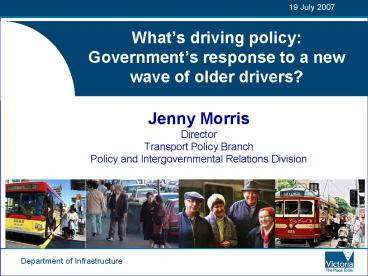Jenny Morris - PowerPoint PPT Presentation
1 / 13
Title:
Jenny Morris
Description:
What's driving policy: Government's response to a new wave of ... Victorian population growth by selected age groups, 1971, ... on PT (especially on trams) ... – PowerPoint PPT presentation
Number of Views:31
Avg rating:3.0/5.0
Title: Jenny Morris
1
Whats driving policy Governments response to a
new wave of older drivers?
19 July 2007
- Jenny Morris
- Director
- Transport Policy Branch
- Policy and Intergovernmental Relations Division
2
Ageing of the community
Victorian population growth by selected age
groups, 1971, 2001, 2031
Source ABS, DSE VIF 2004
3
Current Victorian licence holders
LICENCES ON ISSUE AS AT 23 JANUARY 2007
400000
350000
300000
250000
Female
200000
LICENCES
Male
150000
100000
50000
0
18-25
26-35
36-45
46-55
56-65
66-75
76-85
86-95
96 and
older
AGE GROUP
Source VicRoads Registration and Licensing
database
4
Why is this an important policy issue for
transport?
Share of Average Daily Trips (Weekday) by Sex,
Age Mode of Travel 1994 to 1999
Source Victorian Activity and Travel Survey,
1994 to 1999
5
Current strategies
- Supporting older drivers to drive safely for
longer - Supporting older drivers in transition from
driving to non-driving - Making conventional transport more user-friendly
for older patrons - Removing barriers and providing incentives for
innovative approaches and niche services
6
Supporting older drivers to drive safely for
longer
- VicRoads Victorian Older Drivers Handbook and
Drive safe seminars - Arrive alive! 2007-2016 safer roads and
roadsides, safer vehicles, safer road users
7
Driver to non-driver project
- 2003 Parliamentary inquiry into road safety for
older road users - Governments Response
- - establish specialist working group
- - develop policy
- - develop a communications strategy in
conjunction with the Transport Accident
Commission
8
Driver to non-driverprogress so far
- Literature review of the issues
- Focus group discussions with people in
independent living centres - Supportive policy developed
- Mobility Advisor Pilot study
9
Driver to non-driver Mobility Advisor Pilot
- Aims to test the effectiveness of providing
personalised mobility advice to people who have
stopped driving or maybe about to particularly
in reducing social isolation - Will utilise HACC workers in selected local
government areas - Prospective participants to be sourced through
several possible channels (eg RACV databases,
health professionals, etc).
10
Driver to non-driver Preliminary findings
- Some older people are ultimately accepting of
giving up driving (and self regulate) - but
other responses do occur and many people do not
plan for this eventuality! - Fear of falling on PT (especially on trams)
- Information about alternative services is
important (using appropriate formats and
language) - Importance of walking
- More emphasis is needed on mobility planning as
part of retirement planning generally.
11
Making transport easier to use for all Victorians
- 420 million will spent over ten years to
- Improve public transport accessibility for older
Victorians and people with mobility and visual
disabilities - Deliver free public transport to seniors on
Sundays - Continue the TravelSmart (behaviour change)
program - Help regional and remote communities use existing
transport infrastructure better - Extend and improve cycling and walking options
- Deliver improved taxi services across the state
12
Towards more user-friendly mainstream services
- Stop location, quality and physical accessibility
- Convenient walking distances (to and from stops),
security and amenity (eg appropriate seating)
In-vehicle experience (vehicle design, seating,
travelling and de/acceleration speeds, perceived
safety) - Increased awareness of the specific needs of
older users - Integration between modes, directness of routes,
frequency and reliability - Performance measures that reflect the main issues
of concern for different user groups
13
Niche services
- Multi-purpose taxi program
- Demand responsive services
- Specialised community transport
- Car-based mobility schemes
14
What else may look forward to?
15
Thank -you































